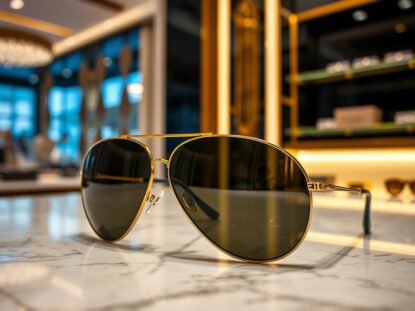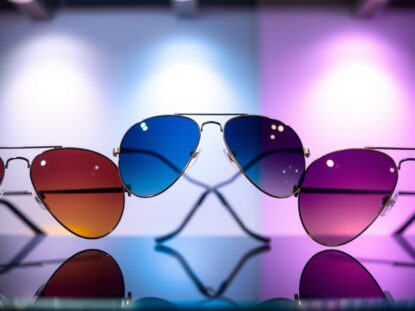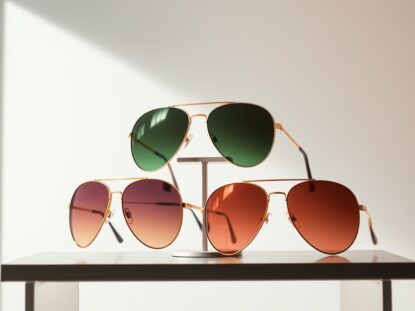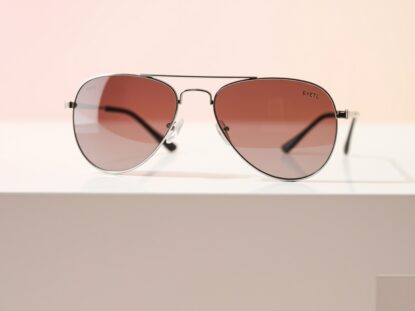

Aviator Sunglasses
Aviator sunglasses stand as one of fashion’s most enduring eyewear silhouettes, distinguished by their signature teardrop lenses and sleek metal framing—a design that has transcended decades while remaining perpetually stylish. Originally designed for pilots in the 1930s, these sunglasses have evolved into a staple fashion item and are widely popular across various demographics.
History and Development
The aviator sunglasses were initially developed by a group of American companies, most notably Bausch & Lomb. The original design was aimed specifically at pilots to reduce glare while flying. The distinctive shape and dark lenses were designed to protect their eyes from the sun at high altitudes, allowing better visibility during flights.
By the 1970s and 1980s, aviator sunglasses began to permeate pop culture, featured prominently in films and worn by celebrities, further cementing their status as a fashion trend. Icons like Tom Cruise in “Top Gun” helped propel aviators into mainstream fashion.

Design and Features
Aviator sunglasses typically have a lightweight metal frame that is both durable and comfortable for extended wear. The lenses come in various sizes, typically featuring a gradient tint that provides an aesthetic appeal while retaining practical benefits. Additionally, many aviators now offer UV protection and polarization, making them suitable for various outdoor activities.
Popularity and Variants
Over the years, different variants of aviator sunglasses have emerged, including those with colored lenses and unique frame designs. Some modern iterations still maintain the classic teardrop silhouette while incorporating contemporary colors and materials, appealing to a younger audience. Aviator sunglasses are often customized, with options for personalized engravings or unique lens colors, adding a personal touch for users.
Market Trends
The aviator sunglasses market has seen significant growth, driven by their versatility and enduring popularity. They are not just a summer accessory but are worn year-round due to their stylish appearance. Various brands now offer aviator styles, from luxury labels to affordable options available at large retailers, making them accessible to a broad audience.
Conclusion
In summary, aviator sunglasses hold a significant place in both fashion and functional eyewear. Their rich history, combined with ongoing trends and variations, ensures they remain a popular choice for consumers around the world.
—
Historical Significance
Aviator sunglasses were first officially contracted by the U.S. military in 1935, with the introduction of the U.S. Army Air Corps D-1 sunglasses, which laid the groundwork for the design that would later become known as aviators. These early models featured rigid frames and were based on the specifications set by military requirements, showcasing both functionality and comfort in mind, combating glare at high altitudes with its teardrop lenses and lightweight metal frame
The iconic style gained further recognition after World War II, especially when General Douglas MacArthur was photographed wearing them during the war. This imagery contributed to their association with military heroism and solidified their image in popular culture.
Design Specifications
Aviator sunglasses are defined by their oversized, teardrop-shaped lenses with a subtle convex curve, aviator sunglasses deliver full visual coverage—effectively shielding eyes from glare and 100% UV rays while maintaining a sleek profile.
Variations and Uses
Today, aviators are offered in various styles to cater to different preferences. Variants like the Ray-Ban Shooter and the Ray-Ban Outdoorsman feature additional design elements like brow bars and specialized temples to enhance usability during various activities. For instance the Shooter model features an innovative built-in cigarette holder, designed specifically for marksmen and hunters, while the Outdoorsman caters to adventurers with its rugged, performance-driven design.
In addition to their fashion appeal, aviators are also popular for practical use in aviation and outdoor sports given their protective features against sunlight. Polarized and photochromic lens options further enhance their functionality, reducing glare and adjusting to different light conditions, although polarized lenses are generally not recommended for pilots according to aviation safety guidelines.
Cultural Impact
Aviator sunglasses have expanded their original purpose and are now a symbol of style and status, frequently appearing in various media, including film, television, and music. Celebrities and public figures frequently don these glasses, continuing the trend that began in the late 20th century and ensuring their relevance in contemporary fashion.
As a result of their rich heritage and versatility, aviator sunglasses remain a beloved choice among consumers, bridging the gap between utility and high fashion.



